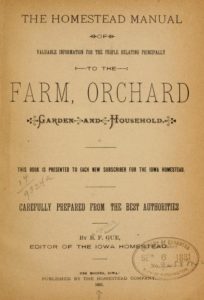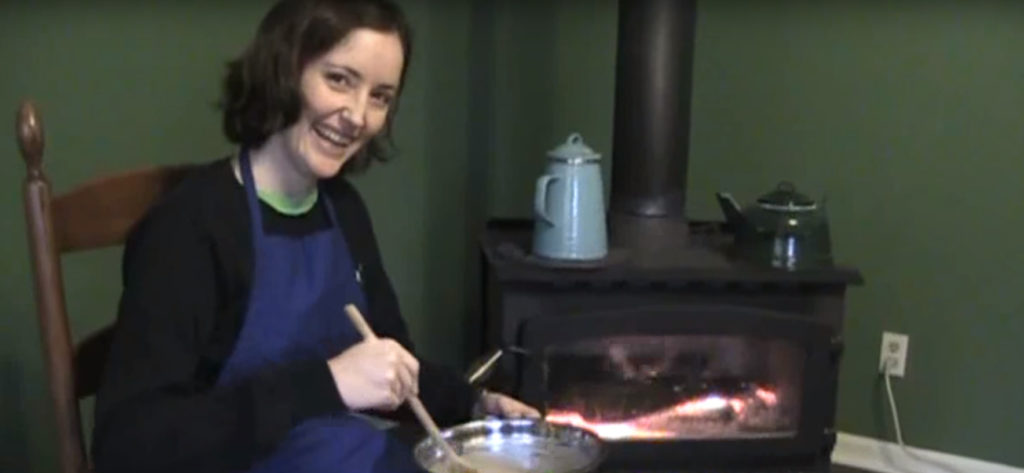How pioneers made laundry soap.
Washing clothes in the days of the pioneers and settlers was an elaborate ritual. Multiple tubs of water, scrubbing boards, handmade soaps, blue dyes for the whites, starch – and all done on a Monday.
Monday was always washing day.
Before the pioneers and settlers could wash their clothes they needed laundry washing soap. What was important was that it had to be a liquid soap that would easily mix in with the clothes.
Hard soaps were readily available and reasonably complex to make, so it was always easier to buy hard soap. But liquid soap wasn’t so easily transported. It had to be made at home.
 The cleaning chapter from the Iowa Settlers Manual of 1881 explains how to make a basic liquid laundry detergent using available materials.
The cleaning chapter from the Iowa Settlers Manual of 1881 explains how to make a basic liquid laundry detergent using available materials.
It’s a recipe we can still use today and involves three separate steps…
The Compound
Contents
“Take five pounds of sal soda, one pound borax, one pound of fresh unslacked lime; dissolve the soda and borax in one gallon of boiling water, and slack the lime in the same quantity of boiling water. Then pour them both into eight gallons of water; stir a few times and let it stand ’till morning, when the clear fluid should be drawn off and kept ready for use.”
The Soft Soap
“One quart of this compound, with three pounds of good bar soap, cut fine, and two pounds of sal soda boiled in three gallons of water for ten minutes, will give four gallons of splendid soft soap.”
The Washing Detergent
“Add half a pint of compound, half a pint of soft soap to four gallons of hot water.”
Sal soda is used to soften the water, as the settlers often would be using well water. Sal soda is also known as washing soda, soda crystals or sodium carbonate. It can be bought from a swimming pool supply store.
Borax is still common and is also known as sodium borate. You can get it from the pool supply shop too.
Unslacked lime is also known as quicklime, burned lime and calcium oxide. You can get it from a large garden center, where it is sold as a fertilizer for lawns and gardens.
All three of these powders are reasonably safe to work with, but do avoid breathing them and getting them on your skin or in your eyes.
You can use any bar soap you choose, but it’s best to get the simplest and cheapest you can and use a fine cheese grater on it.
The settlers also used bluing to brighten their whites in a final rinse. If you want to get the real deal, you can get Prussian blue from an art supply store. It can come in a few forms – you want the stuff that looks like a block of blue chalk.
To use it you should tie the block up in a muslin bag, to protect the clothes from direct contact with the blue dye. It will stain them. Then place the block in the rinse water while you rinse the clothes.
Or you can buy a bottle of Mrs. Stewart’s Bluing. This brand has been around for more than 100 years and is as close to an original pioneer product as you can get.
To brighten your colored clothes, use everyday salt. Just a couple of pinches to the first wash. It needs to be dissolved, so it’s easier to add it to a glass of warm water, dissolve it and then pour that into the wash.
In a future post we will dig into starching. The reasons we use starch in our clothes today have almost nothing to do with why the settlers and pioneers originally used it.
How-to and DIY instructions for making soaps and washing fluids from the year 1896. This chapter of the Home Mechanic’s Manual covers everything you need to know to make your own soaps and washing fluids the old-fashioned colonial way.
The historic instructions in this chapter cover the whole range of soaps that the settler and pioneer families would make for cleaning around the house. The chapter also includes some medicinal soaps, directions for scenting soaps and explains how to prepare emulsines, which were soap substitutes often based on nut oils.
The how-to and DIY in this chapter is from the time of the settler and pioneer – before machines, before power tools and before industrial chemicals, written for colonial people whose lives were built on self-sufficiency and getting the job done properly.
The instructions in the Home Mechanic Manual were geared toward settler families who wanted to start their own businesses, and that’s the approach to soap making in this chapter. Its instructions are comprehensive and well illustrated and can be modified for making soap in bulk, or just for personal use.
The historic Home Mechanics Manual was one of the last great how-to and DIY books written in the colonial period of the settler and pioneer. The century was about to turn and with that the industrial revolution would reach out to the everyday people, changing, sometimes ending thousands of years of hard earned tradition. This great book captured that historic knowledge and preserved it.
How to make soaps and washing fluids from the historic 1896 Home Mechanic Book. 42 Pages. CHAPTER CONTENTS:
What Soap is and How to Test It
Adulteration of Soap
How Soap is Made in General
Soap from Home-Made Caustic Soda
Country Soap-Making or Soap from the Lye or Leached Ashes
Washing Fluids
Soft Soap
- Process for Purifying Soap Grease and Rendering it Suitable for Soap-Making
- How to Prepare New Fat and Separate from it the Skins in which it is Held, which Makes it Liable to Become Rancid
- A New Way to Prepare Animal Fat for Soap-Making, to Keep it Sweet and Facilitate Greatly its Transformation into Soap
- To Make Soap from Grained Tallow
- Preparation of Domestic Soap by Pan on the Open Fire
Rosin Soap
Transparent Soaps
- For Soap-Making by the Cold Way
- Soap-Making by Steam
- Soap-Making in Closed Vessels
- Soap Boiling with Live Steam used Direct
- Boiling with Super-Heated Steam
Adulteration of Soap
- Fused Sulphate of Soda
- Mottled Soap
Toilet Soaps
- From Piesse’s Art of Perfumery
- Camphor Soap, Honey Soap, White Windsor Soap, Brown Windsor Soap, Sand Soap, Fuller’s Earth Soap
Scenting Soaps Hot
Scenting Soaps Cold
Otto of Rose Soap, Tonquin Musk Soap, Orange Flower Soap, Sandal-Wood Soap, Spermacetti Soap, Citron Soap, Frangipanni Soap, Patchouli Soap
Saponaceous Cream of Almonds
Soap Powders
Rypophagon Soap
Ambrosial Cream
Transparent Soft Soap, Juniper Tar Soap, Salt Water Soap, Chlorinated Soap, Iodine Soap, Sulphuretted Soap, Arsenical Soap, Black Soap
Emulsines
Amandine, Olivine, Honey and Almond Paste, Almond Paste, Almond Meal, Pistachio Nut Meal or any other Nut, Emulsin au Jasmin, Emulsin a le Violette, Shaving Paste
If you are interested in soap making, you can download the manual for free.

